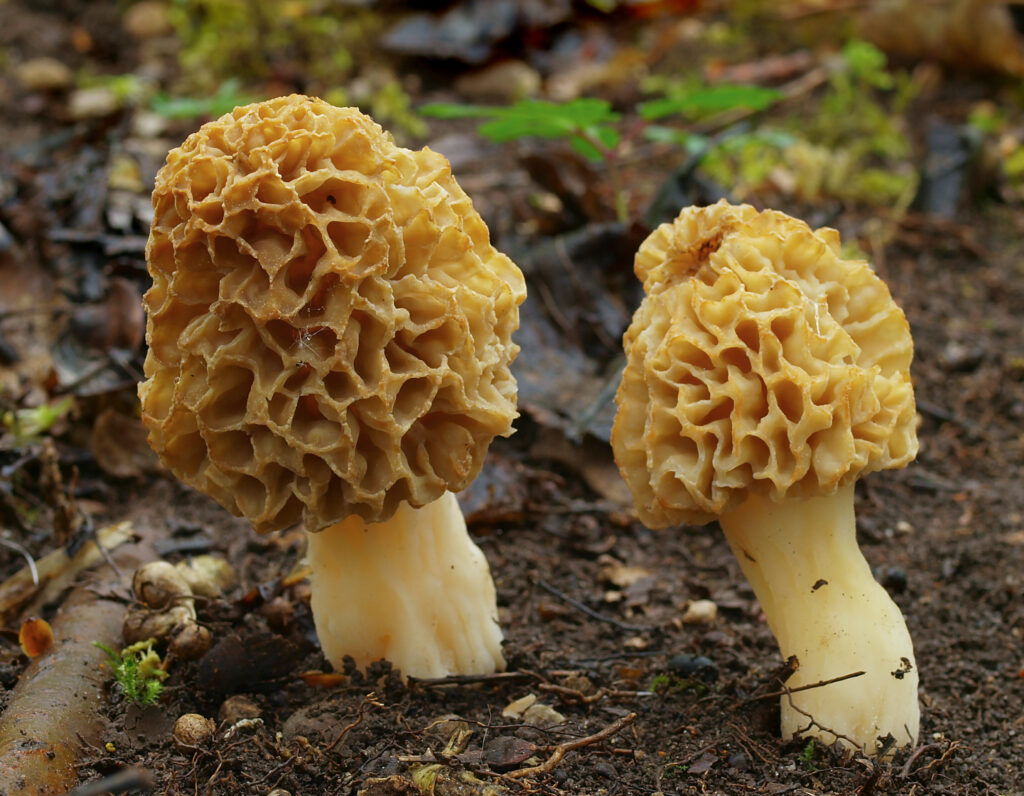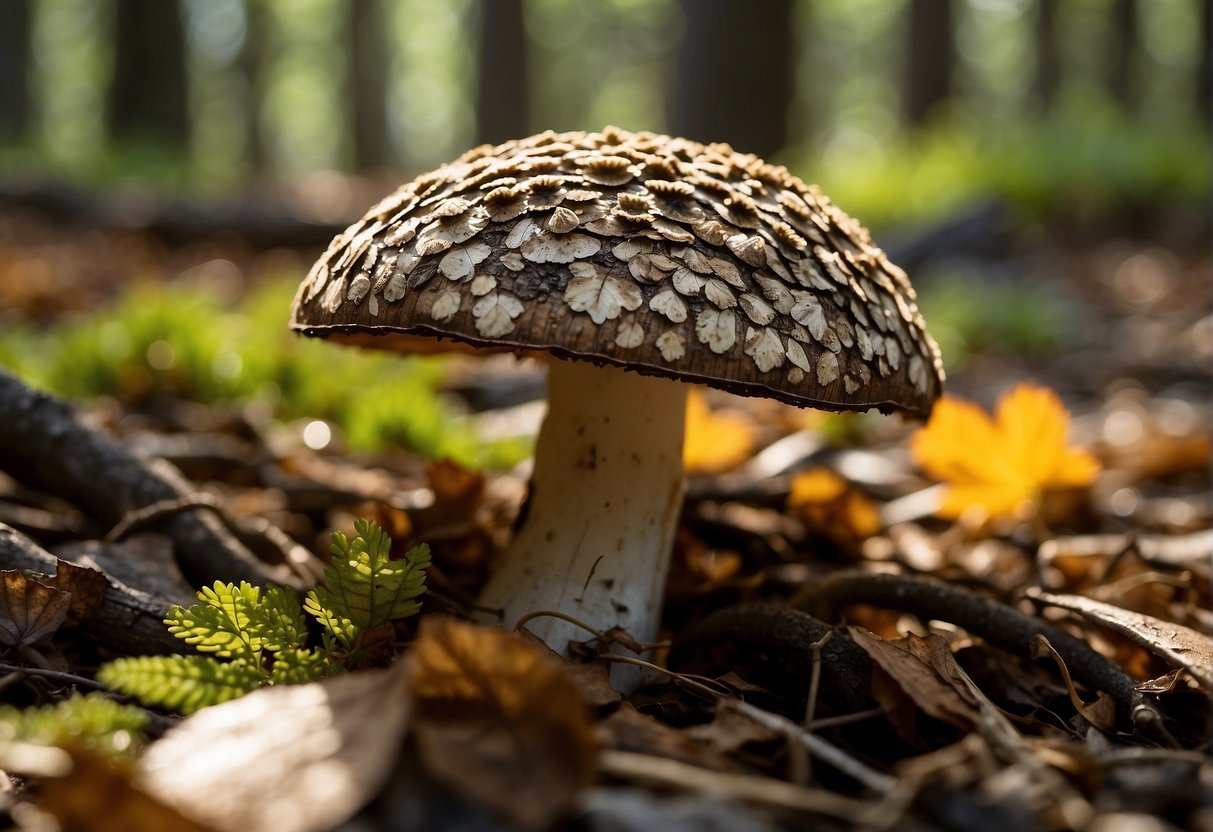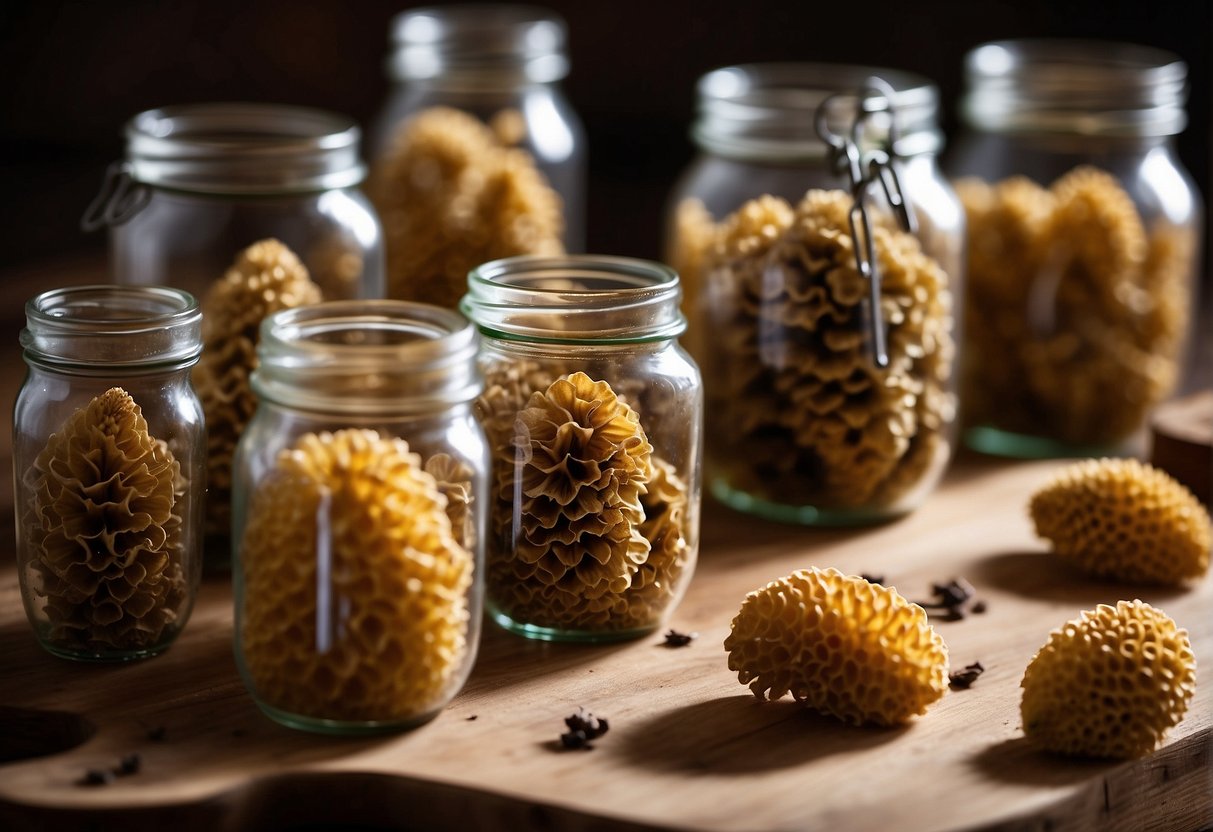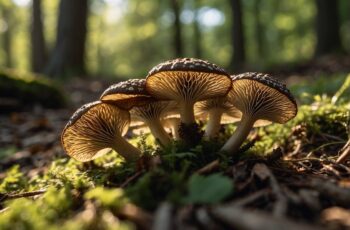As you trek through the springtime woods, your eyes may be lucky enough to spot the golden morel, a true prize amongst wild edible fungi. The golden morel, scientifically known as Morchella esculenta, stands out for its distinctive honeycomb-like cap, which is attached directly to the stipe, or stem, creating a hollow center from tip to ground. Its appearance heralds the arrival of spring and the morel hunting season, a tradition that combines the love of the outdoors with the pursuit of a culinary delicacy.

Foraging for this particular type of morel can be both a challenge and a joy. The joy comes from savoring the unique, nutty flavor that makes golden morels a coveted ingredient in gourmet kitchens. Meanwhile, the challenge lies in their elusive nature; they favor woodlands but never stick to one proven spot, pushing you to understand the environment they thrive in. Your success hinges on recognizing their preferred conditions: damp soil, the presence of hardwood trees like elms and ashes, and just the right amount of sunlight.
Knowing how to properly identify the golden morel is key, as there are false morels out there that are not just inedible, but toxic. Unlike false morels, which often have a cottony or chunky interior, true morels are completely hollow when cut lengthwise. Your outdoor adventures can be richly rewarded when equipped with the right identification knowledge: look for that characteristic yellow-ocher color and remember—the hunt is half the experience. Learn about morel identification and feel the satisfaction of adding foraged golden morels to your next meal.
Biology and Identification
When you’re out in the wild searching for the prized golden morel, understanding its biology and key identifying features is crucial. Knowledge of these details will help you distinguish true morels from their potentially harmful counterparts.
Characteristics of Golden Morels
Golden morels (Morchella esculenta), are recognized by a cap that’s conical and honeycomb-patterned with ridges and pits. The interior should be hollow when sliced, from the tip of the cap down through the stem. If you’re looking for a clear indication of a true morel, be sure to check that the bottom of the stem is attached directly to the cap.
- Cap: Honeycombed, ridged, pitted, and attached at the bottom.
- Stem: White to pale yellow, hollow through the center.
- Color: Ranges from pale cream to yellowish-brown, resembling their namesake.
- Fruiting body: Exhibits a hollow interior indicative of a true morel.
Differentiating Morel Species
While morel mushroom identification can be thrilling, your safety is paramount. Be cautious of false morels, like Verpa bohemica, which have a wrinkled instead of pitted cap and a cotton-like material inside their stems. The golden morel’s spores—key in reproduction—are creamy-white, and formed on the surface of the ridges of the cap.
Here’s how to tell them apart:
- Golden Morel: Hollow interior, cap attached to the bottom of the stem.
- False Morel: Stem often contains cotton-like fibers, cap not consistently attached to the bottom of the stem.
Remember, your ability to accurately identify golden morels is an essential skill that will lead to successful foraging and safe culinary experiences.
Habitats and Foraging Tips

Golden morels, sought after for their unique flavor, have specific habitats and foraging techniques you’ll need to master to successfully harvest these elusive fungi. Understanding their environment and how to forage responsibly ensures a rewarding experience.
Ideal Habitats for Morels
Morels have an affinity for woodland areas rich in hardwood trees like elm, ash, and sycamore. They particularly thrive in soil that’s moist but well-drained, often near river bottoms or in forests with a mix of living and fallen trees. Look for morels in the south during early spring, while the northeast and midwest regions may yield later in the season as soil temperatures rise. Burn areas from wildfire can also be surprisingly fertile grounds for morels a year after the fire.
Foraging Tips:
- Check soil temperature; morels favor grounds that consistently reach about 50–60°F.
- Focus on areas with recent flooding as they provide the necessary moisture morels crave.
- Look around trees, especially elm, ash, poplar, and cottonwood, but be mindful of leaving the area as undisturbed as possible.
Foraging Techniques
When searching for morels, bring a mesh bag; this allows spores to disperse as you walk, encouraging future growth. Move gently through the woods scanning the ground for the distinct conical shape of morels, often camouflaged among leaves and vegetation.
Key Foraging Techniques:
- Start your search on the south-facing slopes as these areas warm up first.
- Investigate fallen trees and stumps, particularly in hardwood forests.
- Use a stick to gently move foliage aside without disturbing the soil or roots.
Safety and Ethics in Mushroom Foraging
Your foray into morel hunting must be conducted with safety and respect for nature. Positive identification is crucial as some mushrooms are toxic look-alikes. Carry a field guide or consult expert tips for a successful hunt to ensure you’re picking the right species.
Safety Reminders:
- Always forage with a buddy or let someone know where you’re going.
- Be aware of your surroundings, and watch out for ditches or uneven terrain.
- Keep in mind the legality and only forage where permitted.
Ethical Considerations:
- Don’t overharvest; take only what you can use to leave enough for wildlife and other foragers.
- Avoid damaging the habitat by not digging or trampling around the foraging areas.
- Practice “Leave No Trace” principles, keeping the ecosystem as undisturbed as possible for future growth and health of the forest.
Seasonal Patterns and Environmental Factors
As a mushroom hunter, it’s critical to understand that golden morels flourish in the temperate days of early spring, with specific climate and weather conditions acting as catalysts for their emergence.
Morel Season Timeline
Early Spring: In many regions, morel season kicks off when dandelions start to bloom and soil temperatures reach about 45 to 50 degrees Fahrenheit. This is generally an ideal time for you to begin your foraging efforts.
- Morel Mushroom Season: Typically spans from late March through May, with peak hunting often occurring in April.
Effect of Climate and Weather
Temperature: Golden morels thrive in warming conditions, but they are sensitive to freezing temperatures, which can severely hinder their growth.
- Climate Impact: Fluctuating weather patterns, particularly warm days followed by cool nights, stimulate morel growth.
- Key Indicator: Soil temperature steadying above 45 degrees Fahrenheit is a green light for foragers.
The hunt for golden morels can turn hiking trails into annual destinations, as many mushroom hunters eagerly anticipate the kick-off of the mushroom hunting season. Your best finds as a forager often come when temperatures consistently rise, so keep a close eye on the weather and soil warmth if you’re planning to hunt these prized fungi.
Culinary Uses and Preservation

Golden morels are a true treasure of the forest, prized for their unique flavor. In this section, we’ll guide you through the best practices of preparing, cooking, and preserving these wild gems.
Preparing Morels for Cooking
To prepare morels for cooking, ensure they are clean and free from any forest debris. Start by placing the morels in a bowl of cool salt water. The salt water helps to remove any grit and can coax out any tiny critters hiding inside. Rinse them gently under running water afterwards but don’t soak them for too long as they are like sponges and can become waterlogged. Pat them dry with paper towels before cooking.
Recipes and Cooking Techniques
Morels are incredibly versatile in the kitchen. They can be sautéed in butter to enhance their rich and earthy flavor. The key to bringing out their exceptional taste is to cook them until they are golden brown. Try incorporating morels into your recipes to create delectable dishes such as creamy morel pasta, morel risotto, or as a sophisticated topping on a steak.
| Cooking Method | Description |
|---|---|
| Sautéed | Lightly fry until golden brown. |
| Baked | Incorporated into casseroles. |
| Grilled | Over low heat for a smoky flavor. |
Storage and Preservation
To enjoy morels year-round, proper storage and preservation are essential. First, never store morels raw as they can spoil quickly. Instead, you could freeze morels, either whole or sliced, on a baking sheet and then transfer them to a freezer bag to store for several months. Drying is another excellent method of preservation; dried morels can last for an extended period and are easy to rehydrate for future culinary use. Both freezing and drying help maintain the morel’s nutrients and flavor.
| Preservation Method | Steps |
|---|---|
| Freezing | Individually quick freeze |
| Drying | Dehydrate and store airtight |
| Pickling | Immersed in a vinegar solution |
Bear in mind that morels are not only a delicacy but also a source of valuable nutrients, which makes preserving them both a practical and delightful endeavor. With these techniques, you’ll ensure your foraged finds don’t go to waste and are ready to enhance any meal.


